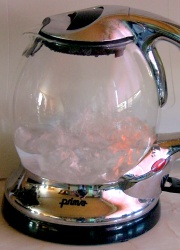How can I reuse or recycle (or repair) a stove top kettle?
 We’ve had an email from long time Recycle This-er Alice in Blogland:
We’ve had an email from long time Recycle This-er Alice in Blogland:
I just killed my stainless steel on-the-hob kettle! Left it on the hob too long – I forgot about it ‘cos the whistle broke ages ago.
They do burn through eventually but I’ve never seen it happen before. It’s started leaking at the seam around the bottom where the sides join the base, and I’m a bit stuck for either re-uses or how to recycle it. Anyone got any ideas?
I think kettles with removable lids look mighty cute as plant pots but with the leak, you might want to put the pot on a plastic saucer in the kettle to catch overspill water – or it might be easier to seal the leak if you know it doesn’t have to be heat-proof too (for example, some waterproof silicone sealant might do the job well enough to use it as a plant pot but would make your tea somewhat plasticky and poisonous…).
Any other ideas for reuses? What about kettle that you refill through the spout so have less reuse-as-a-pot potential?
Anyone got any repair advice or words of caution?























How about as a cute container to store tea in? You’d always be able to find it in the cupboard, or even leave it out on the counter.
There are still people about who repair stuff like that the old fashioned way (and some schools have courses now teaching new generations such old professions) – but I have no idea whether their methods are environmentally friendly. A steel kettle might be harder to adjust than almost any other kind, since they’re usually made in the age of use and throw – there might be no methods developed for repairs. They were made to be chucked and replaced. A traditional blacksmith might be able to help, maybe?
That said, I’d keep it on a shelf for its prettiness, if it looked anything like the charming enamelled one in the picture, and I had the space for it. A glass jar could be put inside to hold summer flowers, for instance. Or one could have dried flowers in it.
Someone with a forge probably could fix it actually…
Update: I’ve taken it apart, bolted what used to be the spout cover/whistle onto my pannier rack, and bolted my rear bike light onto that instead of the seatpost where it was obscured by the pannier rack.
Will post more updates if I find any uses for all the other bits!
I left my kettle on the electric stove and the water boiled out and the kettle looks burnt. I think it was sitting dry on a red hot burner for about 20 minutes. Can I reuse it? The metal on the sides looks like little flakes fell off it onto the stove around the burner, and it has a nasty smell.
Hi Wayne.
What I did was to fill the kettle with water and leave it sitting on dry newspaper for a couple of days. If your kettle is still watertight then the newspaper will dry out and stay dry.
In my case a wet patch appeared, I moved the kettle slightly and another wet patch appeared, I moved the kettle slightly and another appeared etc etc – not much you can do to rescue one with a leak in it as the seal would have to be both non-toxic and fireproof :-(
If yours is still watertight then you’ll just need to clean it up before you use it again – the smell should go away once it’s clean.
Hi Alice,
Thanks for the input. I scrubbed the inside of the kettle and a lot of black flakes came out. I’m just wondering if it’s unsafe/unhealthy if the metal has been compromised to a certain degree by excessive heat. It doesn’t leak water.
Thanks again,
Wayne
Hmm, I think stainless steel is an alloy of aluminium and iron. Iron should be ok as we all have iron in our blood anyway – in fact it’s probably quite good for you to have an extra dietary source of iron!
Aluminium is not so good for you, and is thought to be related to Alzheimer’s.
All this is off the top of my head and I haven’t done any recent research, but I think stainless steel is usually considered safe on the aluminium front, possibly because there isn’t that much aluminium in it compared with the iron content. A magnet should stick to it if it has a high iron content.
Much of the flaking is probably burnt limescale that was on the bottom of the kettle, which I don’t think will do you any harm (although it might not taste great).
Personally I think I’d probably continue to use your kettle if I could get all the flakey bits out ok, but it’s your call!
Take the bottom out and turn it into a lamp or lightshade
I ended up buying a new kettle and inside the new kettle was an information brochure saying that if the kettle is boiled dry to not use it and throw it away. The water was coming out brown so it wasn’t a hard call.
Old stovetop kettles and teapots that have lost their lids can be propped up in trees and hedges with the spout facing downwards (for drainage) and the birds will make use of them for their nests. I have done this in my garden successfully.
Insurance for dental health is very much necessary these
days. Getting it wrong could adversely affect your health for
ever, unlike when buying a car, or choosing where to go on holiday,.
Obviously, you should have the right to inspect dental equipment to make sure it is working properly.